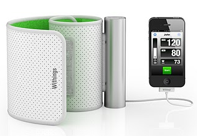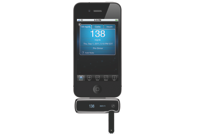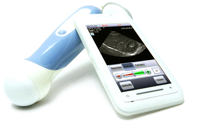Introduction by Karen Lightman, managing director, MEMS Industry Group
Many of you have heard me say that MEMS-enabling Quality of Life (QoL) products are “improving mankind” in ways that we never thought possible (see my blog for Medical Electronics Design). As seen in the recent announcement for the Qualcomm Tricorder XPRIZE (yes that Tricorder, the one from Star Trek!) – the future of medical diagnosis, treatment and rehab is MEMS. I KNOW the winner of the Qualcomm Tricorder XPRIZE will have lots of MEMS inside. To see where MEMS can be found inside today’s QoL products, I am pleased to present Katie Matlack’s blog iOS Medical Peripherals: Convenient and Connected. Clearly, MEMS is and will continue to improve QoL.
By Katie Matlack, Medical Market Analyst, Software Advice
The iPhone and iPad are changing the world of medical devices as we know it.
Thanks to their familiar interface, Web connectivity, and powerful processing capabilities, with the right app and plug-in these iOS devices can work as super smart medical devices that make sharing as easy as the push of a touchscreen button. Consumers can now access increasingly high-quality medical devices, making it easy to be more actively engaged in their own health. And home and rural care givers can benefit from the portability and versatility of iPad and iPhone based devices.
Below I’ll discuss five examples of powerful iOS medical devices I’ve found that already exist.
1) The Withings Blood Pressure Monitor
French company Withings developed this blood pressure monitor that features an app and a cuff that fits most average-sized people. Accurate data on your blood pressure can help you monitor hypertension, which can lead to serious consequences for your heart, brain and kidney. The Withings monitor can even work with an iPod Touch, and runs at $129. You can use the device to share your data with your doctor.
2) ECEM Pulse Oximeter
This device isn’t yet available to the masses, but given its utility I imagine it will be soon. It features a small clip that attaches to your fingertip. The clip beams a light through your fingertip to a receiver on the opposite side; the amount of light received is used to determine how much oxygen is saturated in your blood. Developed by the Electrical and Computer Engineering in Medicine research group together with the Pediatric Anesthesia Research Team at the University of British Columbia, it was originally created to help make anesthesia care safer in the developing world, but can also be useful to patients with heart of lung problems such as emphysema.
3) iBGStar Glucose Meter
From Sanofi-Aventis comes this glucose meter app and plug-in. The glucose meter is a well-known device to anyone with diabetes. Today, diabetics test blood sugar with needles and a clunky kit; the iBGStar offers a small add-on to the iPhone that’s said to give better, more accurate results. Plus, getting your data on your iPhone means you can share it easily, and you can get reminders on your iPhone when it’s time for another check.
4) iPhoneECG Electrocardiogram
This device has a simple setup: just snap a plastic case onto the back of your iPhone and you’re ready to go. The case has two electrodes in the back that, when you press the phone against bare skin of your thumbs or–for a better reading–your chest, can measure and track your pulse. It was built by Alivecor and Oregon Scientific. It’s not perfect, since it admittedly gathers a limited amount of data on your heartbeat, meaning it can’t quite compete against a real ECG. But for e-patients looking to get a good look at their heartbeat or caregivers looking for a quick diagnostic, it might just do the trick.
5) MobiUS SP1 Ultrasound Imaging Device
OK, with a price tag of around $7,500, it’s still not quite a device for the masses. But this ultrasound peripheral and program still runs lots cheaper than traditional machines, and does serve as a step in the road to democratizing access to patient information. Though the device, from Mobisante, doesn’t run on iOS yet, I predict it will soon, since one major obstacle–the lack of a USB port in an iPad or an iPhone–will be eliminated in the latest upgrade to the iPad coming out soon. Wi-Fi and cell connectivity mean images can be shared quickly from the device, meaning caregivers might be able to more easily, frequently, or quickly share data with patients about their joey in the pouch.
Katie Matlack is the Medical Software Analyst at Software Advice, a free online resource that provides home health software reviews and evaluates other software products.








